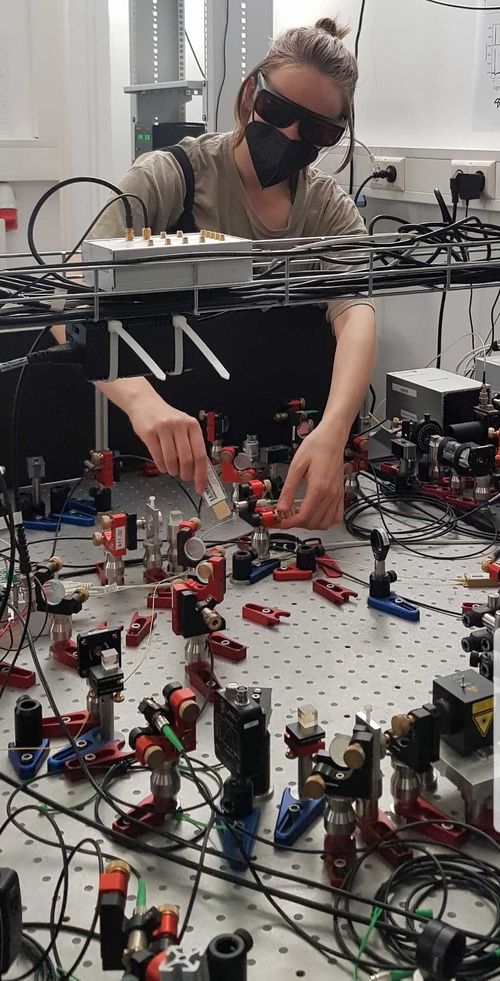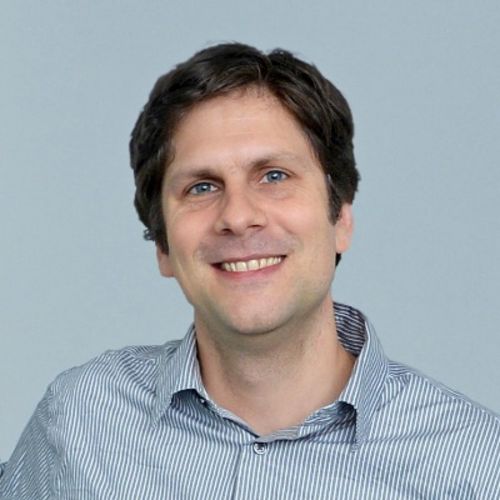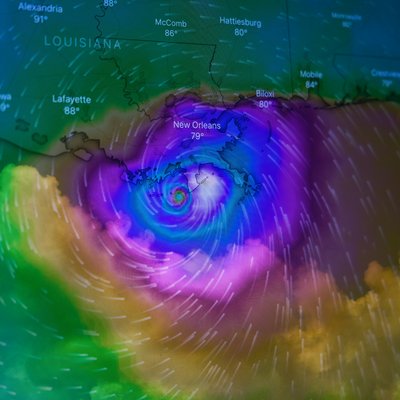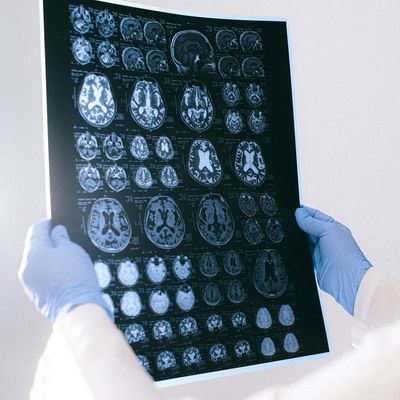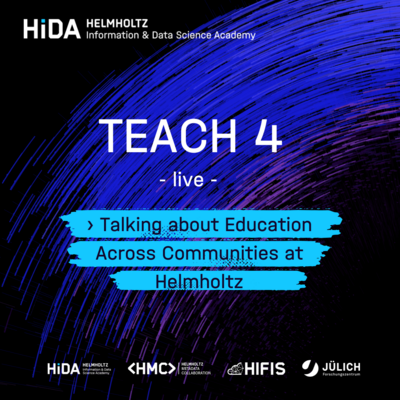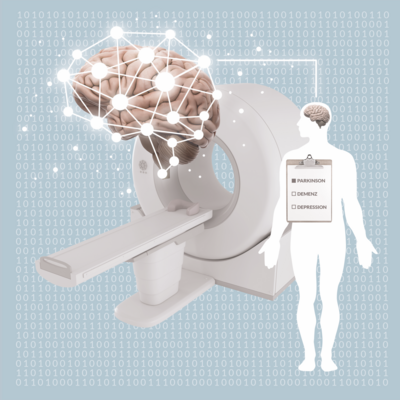Pioneers with broad horizons: Data scientists at HEIBRiDS

Demand is high for young scientists who are well versed in the data sciences as well as in another discipline. At the Helmholtz graduate school HEIBRiDS in the Berlin-Brandenburg region, eleven prestigious institutions have teamed up to train young scientists at this intersection. The range of subjects they cover spans everything from genetic research to astronomy.
In her laboratory at the German Aerospace Center (DLR) Institute of Optical Sensor Systems, Elizabeth Robertson is tinkering with the inner workings of a computer that looks nothing like a conventional one. This computer is made of lasers, lenses, mirrors, and a small cell filled with cesium vapor. “The idea is for this computer to work with light someday, instead of electricity like a conventional PC,” says the young doctoral candidate, describing her work. “Eventually, AI algorithms could run significantly faster on a photonic processor like this one while also consuming far less energy than they do now.” Robertson’s project is part of a special graduate school called HEIBRiDS. Since 2018, the Helmholtz Einstein International Berlin Research School in Data Science has been training young scientists with the goal of equipping them to introduce cutting-edge data science methods into a broad range of specialist disciplines.
“The data sciences are become more and more important for research every year,” explains Uwe Ohler, a specialist in bioinformatics at the Max Delbrück Center for Molecular Medicine and one of the initiators of HEIBRiDS. This is how modern imaging processes create images at very high resolutions—which means the masses of data that need to be stored and processed are growing at an incredible rate as well. Data security and statistical methods are also taking on an increasingly prominent role. But what’s particularly striking is the advances in artificial intelligence. As computers get faster and faster and data volumes grow unabated, algorithms in neuronal networks and machine learning have now become extremely efficient. “In the past, we primarily used computers to automate human capabilities,” says Ohler. “These days, data-driven AI can uncover insights that humans would never detect in the data. This creates scope for entirely new ways of looking at scientific problems.”
In light of this development, demand is growing for experts who are well versed in the latest data science methods and develop innovative processes that can be used in a wide range of subject areas—from biology, to physics, through to geological research and archeology. The Helmholtz Information & Data Science Academy (HIDA) has responded to this demand by setting up six graduate schools across Germany. Established in 2018, HEIBRiDS was the first of these schools—and thus their pioneer. Located in the greater Berlin region, HEIBRiDS is supported by twelve institutions: Berlin’s three main universities, the Charité – Universitätsmedizin Berlin hospital, the Einstein Center Digital Future, and the six Helmholtz Centers in the region.
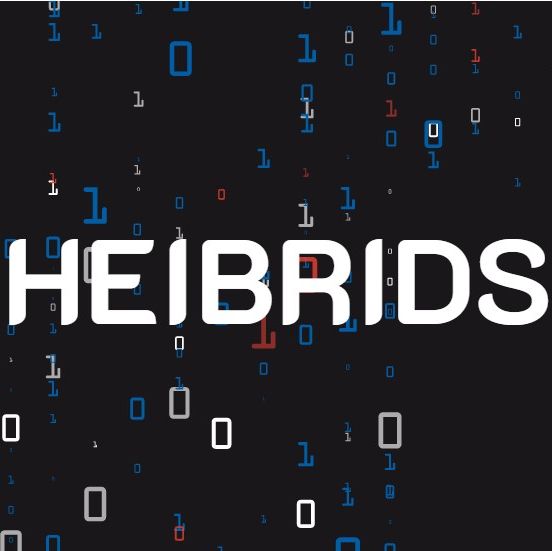
Diverse research - the institutions behind HEIBRiDS
The institutions behind HEIBRiDS:
Humboldt-Universität zu Berlin
Charité Universitätsmedizin Berlin
Einstein Center Digital Future (ECDF)
Deutsches Elektronen Synchrotron (DESY)
Deutsches Zentrum für Luft- und Raumfahrt (DLR)
Deutsches GeoForschungsZentrum Potsdam(GFZ)
Helmholtz-Zentrum Berlin (HZB)
The Plus: Double Support
The graduate program features several unique characteristics, including the fact that each of the 25 doctoral candidates at HEIBRiDS is supervised by two professors—with one half of the tandem specializing in the computer sciences and the other in a different discipline. “This gives the participants really in-depth insights into the two areas, both in the computer sciences as well as the respective discipline,” Ohler says. “The result is that they come into contact with very different approaches and ideas.” Elizabeth Robertson, who completed a combined course in physics and computer science in England, is impressed by the concept: “My two supervisors see my project from very different perspectives, and that’s extremely valuable for my work,” she says. “Plus, I have two offices at two different research facilities!”
“My two supervisors see my project from very different perspectives, and that’s extremely valuable for my work.”
Elizabeth Robertson, doctoral researcher at HEIBRiDS
One of the other key features of HEIBRiDS is the enormous diversity of the doctoral topics it covers. This is due to the broad range of subjects at the participating institutions, spanning everything from polar research, to astronomy and molecular biology, through to the geosciences. One project is looking at how earthquakes can be predicted more accurately by using a self-learning algorithm. Another is aiming to make the process of charging electric buses more efficient with solar modules via AI. And one doctoral candidate aims to improve analyses of microscope images of the lungs—with the help of a neuronal network, a software program that imitates the way the human brain works.
Hands-on Work and Exchange Opportunities
Elizabeth Robertson, on the other hand, doesn’t just use a mouse and keyboard when working on her doctoral thesis, but also a screwdriver and soldering iron sometimes, too. “Right now, I’m trying to build a type of light storage system in the (German Aerospace Center) DLR Institute of Optical Sensor Systems in Adlershof,” she explains. “It consists of cell filled with cesium vapor that we want to use to capture and store light from lasers.” This device would be a key element in a new type of computer that works with light rather than with electrons, the standard method. This “photonic processor” would offer an incredible advantage because it could run specific AI algorithms at extremely rapid rates: “Some operations that are very complicated on a computer are very simple with light,” Robertson explains. “You simply let light pass through a lens, and the mathematical operation is done.” Thanks to this approach, a photonic processor wouldn’t just run AI algorithms at a rapid rate but would also require significantly less energy for this purpose. “The chips used today can become extremely hot, and it’s becoming increasingly difficult to dissipate this heat,” Robertson explains. “Our processor wouldn’t have this problem and would consume considerably less electricity, conserving resources.”

The tandem supervisor approach at HEIBRiDS isn’t the only aspect Robertson appreciates about the program; she also enjoys being in contact with the other participants at the graduate school. “We meet every two weeks, and a projects is presented at every session,” explains Robertson. “There’s always a lot to talk about afterwards, and we have really lively discussions.” Because even though the doctoral candidates work in different subject areas, the data methods they use often have striking similarities. For example, an algorithm that reveals anomalies in an X-ray image could potentially be used in modified form to track down patterns in measurements from a particle accelerator.
“The program has brought together experts from various areas of Berlin who otherwise wouldn’t typically come into contact with each other.”
Uwe Ohler, spokesperson of HEIBRiDS
The program also includes a series of seminars that offer high-caliber talks on a wide range of topic areas, such as machine learning for quantum computers and using AI in mobile communications. “The seminars are really exciting, even for me,” notes HEIBRiDS co-initiator Uwe Ohler. “They give me a chance to gain insights into other areas, and I actually get new ideas for my own research now and then.” The MDC researcher notes that experience of the program has been positive so far, and it has succeeded in fostering a sense of shared identity among the participants. “Plus, HEIBRiDS plugs a key gap on the Berlin research scene by creating closer links between the universities and the Helmholtz Centers,” Ohler says. “The program has brought together experts from various areas of Berlin who otherwise wouldn’t typically come into contact with each other.”
Future Plans
Looking to the future, Ohler would like to see these contacts stepped up even further, for example with BIFOLD (Berlin Institute for Foundations of Learning and Data), a research center that was only recently set up in Berlin and aims to become one of the leading AI institutes in Germany in the coming years. BIFOLD is also planning to establish a graduate school, and joint events could further enhance the field’s profile. “Going forward, the team here at HEIBRiDS also wants to bring more international computer science firms such as Google and Amazon on board,” Ohler explains. “And we also want to create closer networks with the local start-up scene, which could offer potential in terms of internships, for example.” Besides this, high-tech companies are also urgently seeking young specialists who can transfer innovative IT methods to their companies. In this sense, HEIBRiDS graduates offer ideal qualifications.
And what lies ahead for Elizabeth Robertson? She has been conducting research for her PhD since 2020 and could complete it by the end of 2023. “After that, I could see myself continuing to work in the field,” she says. “The project here is really fun, especially the tasks in the lab, when I have the chance to get to work with the screwdriver myself.” Despite this, her dream job is a few floors further up: “Ideally, I’d like to be an astronaut,” the 25-year-old says. “Unfortunately, I was still too young for the last round of applications.” She will have the opportunity to give it another try, though. And if that happens, there’s a possibility that a HEIBRiDS graduate could lift off to outer space for the first time.
Author: Frank Grotelüschen

